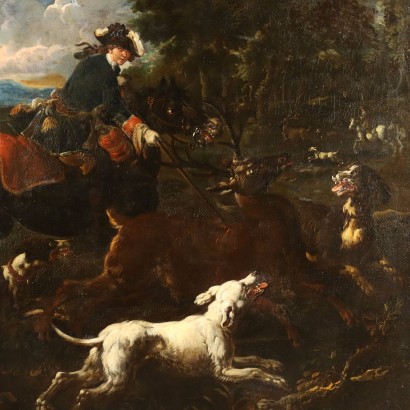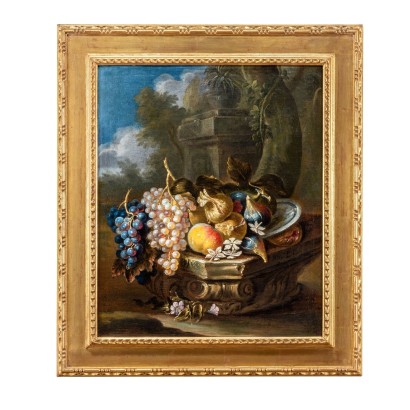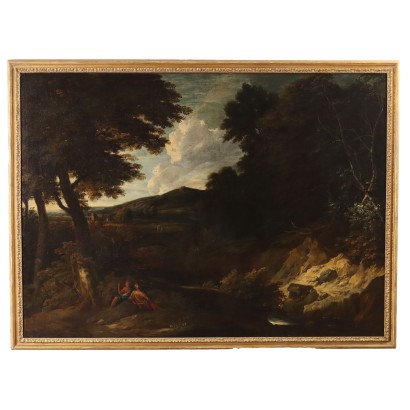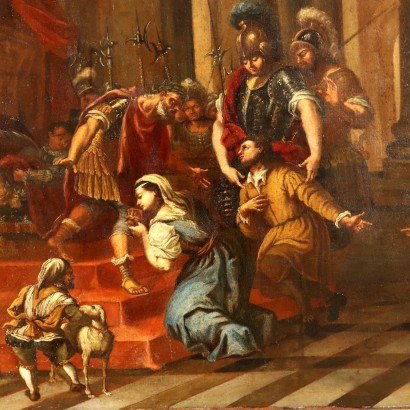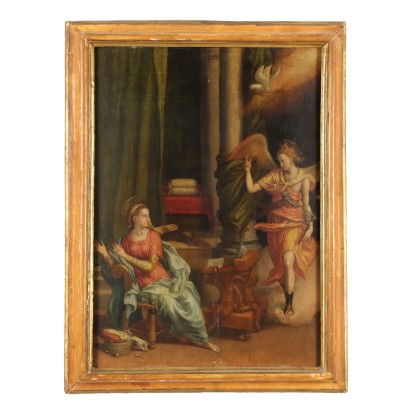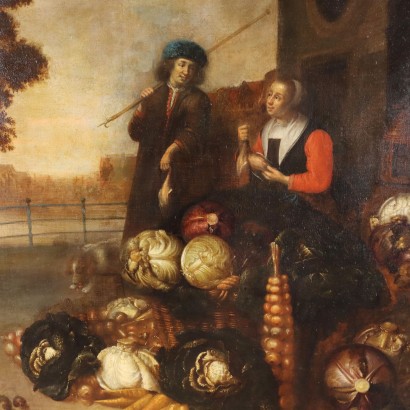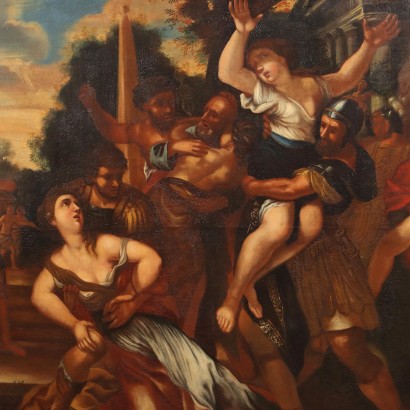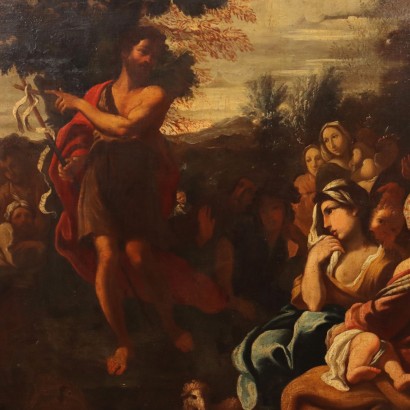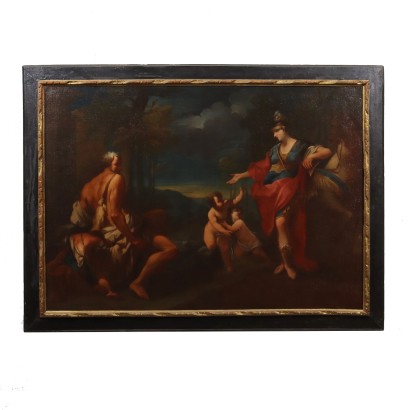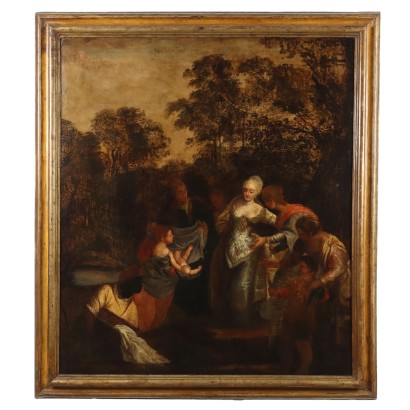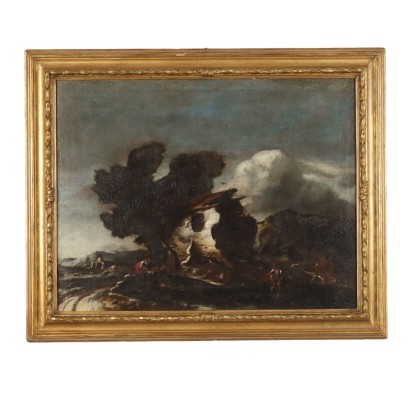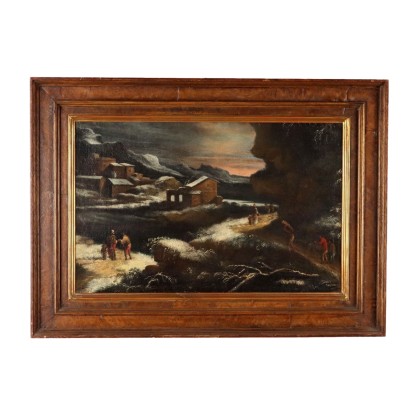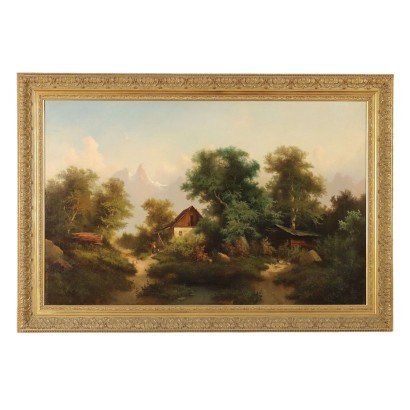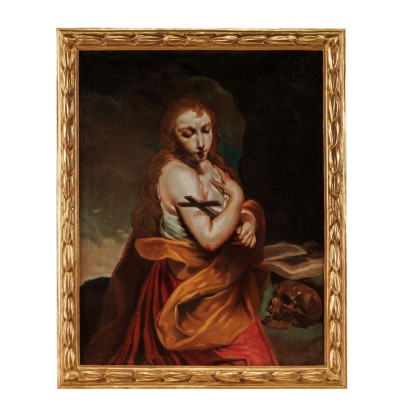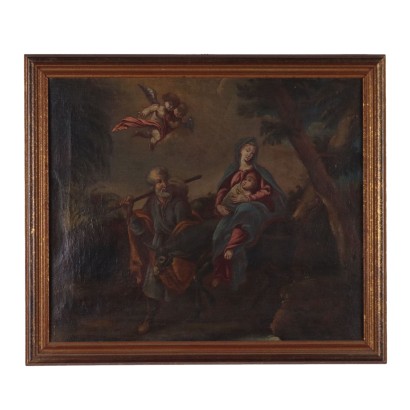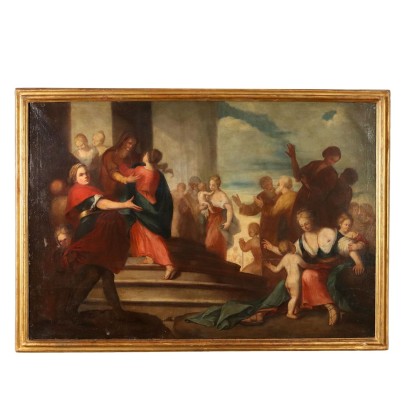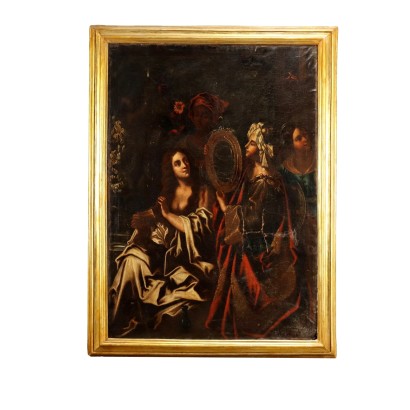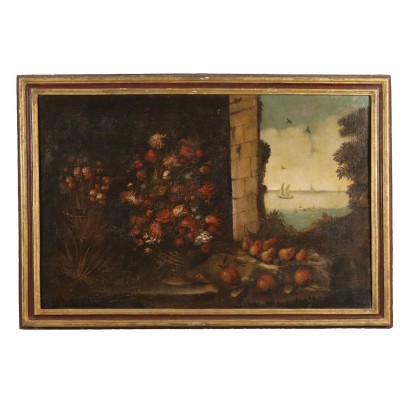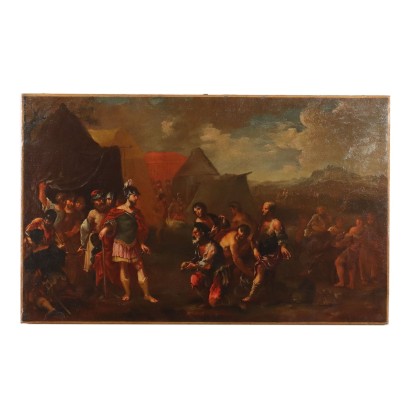Antique Painting Philip Peter Roos Hunting Scene '700 Canvas - Hunting Scene
Features
Hunting Scene
Artist: Philipp Peter Roos (1655 ca.-1706) Attributed to
Artwork title: Scena di caccia
Artistic school: North-European School
Age: 18th Century / 1701 - 1800
Subject: Scene with Figures
Artistic technique: Painting
Technical specification: Oil on Canvas
Description : Scena di caccia
Oil on canvas. Northern European school of the 18th century. The large scene, set in a Nordic landscape, with thick vegetation under impervious blue peaks, represents the culminating moment of a hunt for a fawn: the knight, who occupies the upper part of the scene, is spearing the prey, terrified and broken down in agony; all around the pack of dogs participates, running around the rider and the prey. Among all, the dog in the center at the bottom stands out, the only one with light fur: the intense brightness that it emanates and which brings out the accurate design of its fur, the moving muscles, the exalted expression of the animal, makes it they make the protagonist of the scene, drawing the gaze towards themselves, while all the other figures, including the knight, become the outline, accurate and precise but not the protagonist. It is precisely the accuracy in painting the animals that places the work close to the production of Philip Peter Roos, known as Rosa da Tivoli: originally from Frankfurt but then moved to Rome, where he remained until his death, this artist was very active above all as a painter of animals, shot in the foreground against landscape backgrounds and executed with rich color and intense light effects. The great success he had and the consequent very large production (sometimes to the detriment of the quality of the works), justify the frequent attribution to this painter of works with a subject and pictorial technique close to his, such as the one presented here, which however is not documented and validated. Restored and relined, the painting is presented in a late 19th century frame.
Product Condition:
Product in good condition, has small signs of wear. We try to present the real state as fully as possible with photos. If some details are not clear from the photos, what is stated in the description applies.
Frame Size (cm):
Height: 163
Width: 150
Depth: 6
Artwork dimensions (cm):
Height: 145
Width: 134
Additional Information
Artist: Philipp Peter Roos (1655 ca.-1706)
Born in Frankfurt am Main in around 1655 to the painter Johann Heinrich Roos, Philipp Peter left for Rome in 1677 thanks to the benevolence of the Landgrave of Hesse, to perfect himself and then return to court. A pupil of Giacinto Brandi, Roos married his daughter and decided to stay in Italy. From 1683 he was a member of the Congregation of the Virtuosi at the Pantheon and from 1684 he moved to Tivoli and hence his nickname. He achieved great success, so much so that his paintings were requested by the main art lovers in Europe. By virtue of the speed with which he painted, it is very difficult to count his production, sometimes not always up to the level of his talent due to an unruly life dedicated to frequenting taverns, causing a discontinuous accuracy of the brush. Rosa da Tivoli was very active above all as a painter of animals (with which he surrounded himself in his home), shot in the foreground against landscape backgrounds and executed with rich color and intense luministic effects. The artist died in Rome in 1706.Artistic school: North-European School
Age: 18th Century / 1701 - 1800
18th Century / 1701 - 1800Subject: Scene with Figures
Artistic technique: Painting
La pittura è l'arte che consiste nell'applicare dei pigmenti a un supporto come la carta, la tela, la seta, la ceramica, il legno, il vetro o un muro. Essendo i pigmenti essenzialmente solidi, è necessario utilizzare un legante, che li porti a uno stadio liquido, più fluido o più denso, e un collante, che permetta l'adesione duratura al supporto. Chi dipinge è detto pittore o pittrice. Il risultato è un'immagine che, a seconda delle intenzioni dell'autore, esprime la sua percezione del mondo o una libera associazione di forme o un qualsiasi altro significato, a seconda della sua creatività, del suo gusto estetico e di quello della società di cui fa parte.Technical specification: Oil on Canvas
The oil painting is a painting technique using powder pigments mixed with bases in inert and oils.Other customers have searched:
Pittura antica, artisti italiani, pittura olio su tela, arte 800, pittura antica, arte novecento, oggetti d'arte, ritratto di signora, dipinto animali, quadro paesaggio montano, dipinto olio su tela, dipinto antico, dipinti natura morta, quadro antico, quadro del '600, pittori italiani quadri olio su tela paesaggi, paesaggio marino dipinto, paesaggio invernale dipinto, paesaggio autunnale dipinto, dipinto di paesaggio, arte antica, quadro religioso..
Se sei un appassionato d'arte, non perderti i nostri approfondimenti sul Blog Arte Di Mano in Mano e su FineArt by Di Mano in Mano - Arte:
Leggi di più
Ecco alcuni tra i principali articoli:
Vedute
Falsi nell'arte antica
Un messaggio di fiducia per ripartire
La potenza espressiva dell'arte figurativa etiope
Breve Storia del Collezionismo
Giorgio Upiglio, maestro dei libri d'artista
Matthias Withoos detto "Calzetta bianca"
San Rocco pensaci tu - Classic Monday
Dai un'occhiata alle nostre rubriche di divulgazione sull'arte:
Epoche
Lavorazioni e tecniche
Mostre ed Eventi
Protagonisti
Se sei appassionato di pittura antica, con tutta probabilità gusterai le schede di questi stupendi quadri:
"Dio parla a Noè dopo il diluvio", Jacopo da Ponte, detto il Bassano, seconda metà XVI secolo
Crocifissione, maestro della misericordia dell'accademia, terzo quarto del XIV secolo
Erminia incontra i pastori, Camillo Gavassetti, Seconda metà anni Venti del XVII Secolo
Eroine dell'antichità, Francesco Conti, XVIII secolo
Hieronymus III Francken, La Negazione di Pietro, XVII secolo
Jefte e la figlia, Girolamo Forabosco e aiuti, XVII secolo
L'Accademia di Platone, piccolo arazzo, fine XVII - inizio XVIII secolo
Maddalena e San Giovanni Battista
Natura Morta, Bartolomeo Arbotori, XVIII secolo
Sacra Famiglia con San Giovannino, Bartolomeo Ramenghi, scuola di, prima metà XVI secolo
Testa Femminile, Andrea del Sarto, ambito di, post 1522
Uva, fichi, melagrana e pesche su un capitello - Maximilian Pfeiler, primo quarto XVIII secolo
Sapevi che l'arte può essere anche un ottimo investimento (e non solo per grandi portafogli)?
L'Arte tra Collezionismo e Investimento
FineArt: Arte come investimento
Leggi di più
Ecco alcuni tra i principali articoli:Vedute
Falsi nell'arte antica
Un messaggio di fiducia per ripartire
La potenza espressiva dell'arte figurativa etiope
Breve Storia del Collezionismo
Giorgio Upiglio, maestro dei libri d'artista
Matthias Withoos detto "Calzetta bianca"
San Rocco pensaci tu - Classic Monday
Dai un'occhiata alle nostre rubriche di divulgazione sull'arte:
Epoche
Lavorazioni e tecniche
Mostre ed Eventi
Protagonisti
Se sei appassionato di pittura antica, con tutta probabilità gusterai le schede di questi stupendi quadri:
"Dio parla a Noè dopo il diluvio", Jacopo da Ponte, detto il Bassano, seconda metà XVI secolo
Crocifissione, maestro della misericordia dell'accademia, terzo quarto del XIV secolo
Erminia incontra i pastori, Camillo Gavassetti, Seconda metà anni Venti del XVII Secolo
Eroine dell'antichità, Francesco Conti, XVIII secolo
Hieronymus III Francken, La Negazione di Pietro, XVII secolo
Jefte e la figlia, Girolamo Forabosco e aiuti, XVII secolo
L'Accademia di Platone, piccolo arazzo, fine XVII - inizio XVIII secolo
Maddalena e San Giovanni Battista
Natura Morta, Bartolomeo Arbotori, XVIII secolo
Sacra Famiglia con San Giovannino, Bartolomeo Ramenghi, scuola di, prima metà XVI secolo
Testa Femminile, Andrea del Sarto, ambito di, post 1522
Uva, fichi, melagrana e pesche su un capitello - Maximilian Pfeiler, primo quarto XVIII secolo
Sapevi che l'arte può essere anche un ottimo investimento (e non solo per grandi portafogli)?
L'Arte tra Collezionismo e Investimento
FineArt: Arte come investimento
Product availability
The product can be seen at Cambiago
Immediate availability
Ready for delivery within 2 working days from ordering the product.



